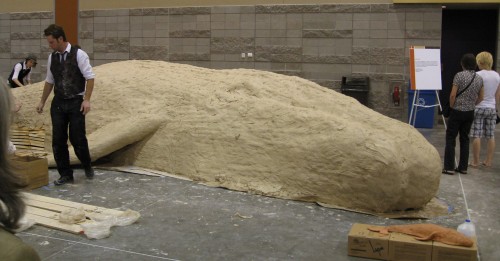Intense clay overload (in a good way) — NCECA Phoenix
The past three days I’ve been immersed in clay. Sounds muddy, but what I mean is, of course, NCECA: demos, tools, galleries, other clay artists, techniques, long-time friends from St. Louis, Metro Light Rail, even a little shopping, and downtown Phoenix: all those things compressed into a fairly short amount of time, in three long but stimulating days.
The Potters as Sculptors, Sculptors as Potters show was fabulous, and folks who made the trip out to Mesa Community College saw a broad yet focused themed show that added a lot to the exhibition experience at NCECA. The room was light and spacious, and packed full of pairs of pieces showing the range in various artists’ work, and how they deal with the duality of making both vessels and sculpture. (Here’s a shot looking into the gallery. My pieces, Stacked Toad Teapot Effigy and Venomosity are the two objects nearest to the camera.) Saint Louis clay artist James Ibur finessed an adroit and thoughtful piece of curation in organizing this show, as well as doing a lot of hard work.
 The bulk of the event was deep in the bowels of the Phoenix Convention Center, and almost all of it was nearly simultaneous. To make the most of NCECA you have to be good at time management and willing to switch gears mid-stream. I watched a Korean Onggi potter make really big pots in the traditional style. He made the coil of beige clay at his foot by stretching 25 pounds of clay all at once on the floor like a giant taffy loop. He would then rest the coil on his shoulder while feeding it onto the top of the pot. He said at home each potter made 30 of these in a day! That’s a lot of kim-che storage — and a lot of clay.
The bulk of the event was deep in the bowels of the Phoenix Convention Center, and almost all of it was nearly simultaneous. To make the most of NCECA you have to be good at time management and willing to switch gears mid-stream. I watched a Korean Onggi potter make really big pots in the traditional style. He made the coil of beige clay at his foot by stretching 25 pounds of clay all at once on the floor like a giant taffy loop. He would then rest the coil on his shoulder while feeding it onto the top of the pot. He said at home each potter made 30 of these in a day! That’s a lot of kim-che storage — and a lot of clay.
There were also on-site installations constructed during the course of the meeting, like this one of a California gray whale made of clay packed onto slat-armature. The mini-whale in red clay on the boxes is the artist’s maquette, and you can just see a few slats still un-clayed at the far left edge of the photo.
the course of the meeting, like this one of a California gray whale made of clay packed onto slat-armature. The mini-whale in red clay on the boxes is the artist’s maquette, and you can just see a few slats still un-clayed at the far left edge of the photo.
The NCECA exhibitors’ hall is also a great place to shop for the latest tool, equipment, or silly clay tee-shirt (“Throwing my life away” “Tee-shirt for my clay body”, etc). But the best tool ideas I picked up were being used by the demonstrators, like this one used by the Korean potter above: it’s a wooden hand-held anvil used on the inside of the pot while the outside is beaten with a wooden paddle. This thins the clay and compresses it, making the walls of the pot stronger and reinforcing the joins between the coils. Wood tends to stick to wet clay, so the face of the tool has been textured so it releases more easily. It also leaves a great texture behind. But, it wasn’t available for sale in the exhibition hall, so if you want one, you’ll have to make it yourself (I’ve always used a river-cobble as an anvil).
it’s a wooden hand-held anvil used on the inside of the pot while the outside is beaten with a wooden paddle. This thins the clay and compresses it, making the walls of the pot stronger and reinforcing the joins between the coils. Wood tends to stick to wet clay, so the face of the tool has been textured so it releases more easily. It also leaves a great texture behind. But, it wasn’t available for sale in the exhibition hall, so if you want one, you’ll have to make it yourself (I’ve always used a river-cobble as an anvil).
I mentioned shopping, and that’s because much of the art on display was for sale. Probably the most notorious selling frenzy at the conference is the Cup Benefit sale, where artists donate cups for a sale, the proceeds of which go to art scholarships. The cups are displayed for two days, then, on the third day, they throw open the doors and let people in a few at a time to shop. The cups are donated by lots of artists, from plain folk to rock-star potters — the most famous names in the business — so the line to get in is long, and people arrive early. By early I mean 4.30am! Although I had my eye on a specacular piece with burrowing owls stencilled on it, it was long gone by the time I got in. So I contented myself with two appealling cups by potters unknown to me — oddly, both named Reilly/Riley.
